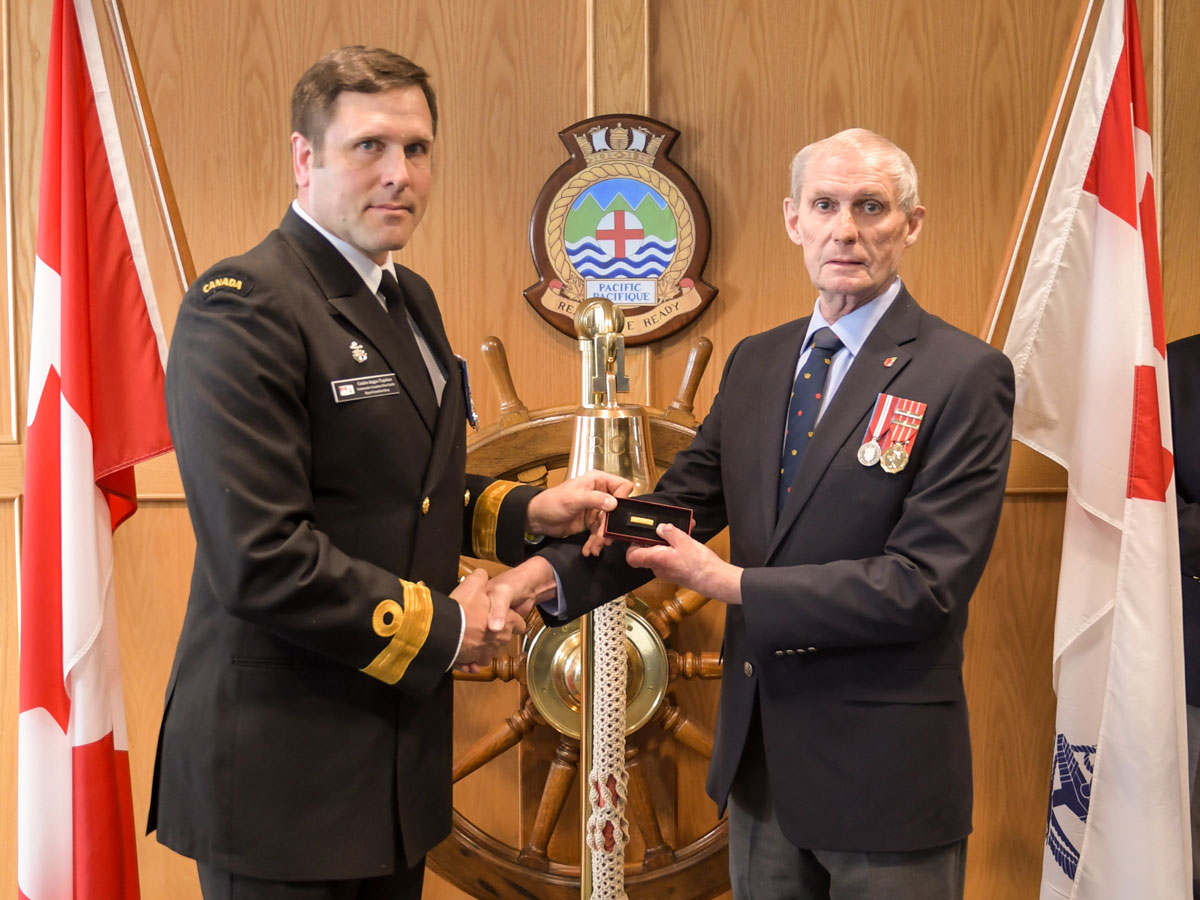Kootenay survivor honoured after 50 years
By Lookout on May 21, 2019 with Comments 1

Cmdre Angus Topshee presents Cdr (Retired) Al Kennedy with athe Wound Stripe on May 14. Kennedy was severely injured in the HMCS Kootenay explosion on Oct. 23, 1969. Photo by SLt Michael Déry
Peter Mallett, Staff Writer ~
As the 50th anniversary of the HMCS Kootenay explosion approaches this fall, one of its survivors has finally been honoured with a Wound Stripe, a distinction worn on the sleeve of military members wounded in action prior to 2001.
Commander (Retired) Al Kennedy, 77, received the honour from Commodore Angus Topshee, Commander Canadian Fleet Pacific, last Tuesday at a ceremony in D100.
The Victoria resident was the Engineering Officer in Kootenay on the morning of Oct. 23, 1969. Just after 8 a.m. there was an explosion in the ship’s engine room that killed nine people, including seven of the 10 men in Kennedy’s engine room team.
The tragedy is considered the Royal Canadian Navy’s worst peace-time accident, so it was with a heavy heart and tears that Kennedy addressed those at the ceremony.
“I cannot forget the nine men who lost their lives that day, and of course their families, wives, children, parents and friends who were bereft,” said Kennedy. “It was a terrible experience for everyone, and I survived, but not a day goes by when I don’t think about it.”
The Wound Stripe Kennedy received is the forerunner of the present-day Sacrifice Medal, created in 2001 to recognize members of the CAF, a member of an allied force, or a Canadian civilian under the authority of the Canadian Forces who died or was wounded under honorable circumstances as a direct result of hostile action.
Before presenting him with this honour and a ceremonial plaque, Cmdre Topshee congratulated Kennedy for his strength and character in the incident. He then apologized that it had taken so long for him to be recognized by the Royal Canadian Navy.
“I am overwhelmed by the horrific experience you and other Kootenay crew members had,” said Cmdr Topshee. “Your story is one that I had heard as a member of the junior ranks, and it is unbelievable that you managed to leave the engine room and somehow make it up on to the bridge.”
The Explosion
Kootenay was part of a nine-vessel Canadian Task Group that was exercising in waters south of Plymouth England when the ship was ordered to carry out a periodic full power trial.
As the ship’s steam power plant reached maximum revolutions of 5,750 RPMs, a mechanical flaw in the gearbox quickly overheated it to a temperature of 650 F. An explosion ensued and caused a fireball that raced through the engine room, up its hatches and onto the main passageway in the ship.
Kennedy, Petty Officer First Class John MacKinnon (starboard throttle), and Able Seaman Allan ‘Dinger’ Bell (main engine room temperature readings) were the only ones in the engine room who survived but were all severely injured in the ordeal.
Those who died in the engine room were:
- Chief Petty Officer First Class Vaino ‘Ski’ Partanen (Chief Engine Room Officer Artificer);
- Chief Petty Officer Second Class William Alfred ‘Billy’ Boudreau (Engine Room Chief);
- Petty Officer First Class Eric George Harman (port throttle);
- Leading Seaman Pierre ‘Pete’ Bourrett (recording at the console);
- LS Thomas Gordon (fire and bilge pump);
- LS Gary Wayne Hutton (torsion meter readings); and,
- Able Seaman Michael Allen Hardy (main engine temperature readings).
- Petty Officer Lewis John Stringer and Ordinary Seaman Nelson Murray Galloway were also among the dead.
Alerting the Crew
Kennedy and his two surviving engine room mates climbed up the engine room ladder and out the front hatch. He recalls how the smoke in the engine room was so thick he couldn’t see his own feet on the ladder, which made for difficult footing. His hands were so badly burned it was difficult to climb the ladder and open the hatch.
“The time it took to go up the ladder was only seconds, but it seemed like an eternity,” said Kennedy. “The only thing going through my mind was a feeling of sadness that I was going to die and not be able to see my wife or three-month-old infant son.”
After the explosion the danger was not over for the Kootenay. The unmanned turbines were still receiving steam from the boiler and the ship was charging ahead at full speed. The wheelhouse had filled with smoke and had to be abandoned, which left no one at the controls.
Eventually, fire-fighting help and supplies arrived with the assistance from HMCS Saguenay and a Sea King helicopter. An emergency helm station was established to override the ship’s controls and shut off the engine.
Kennedy suffered severe burns to approximately 30 per cent of his body, and smoke inhalation. Much of his clothing and hair had been burned away and he suffered soft tissue, tendon and muscle injuries; later he suffered Chronic Pain Syndrome and Post-Traumatic Stress Disorder. He was evacuated by helicopter to HMCS Bonaventure and later to a burn hospital in England for two months of treatment. He then returned to Canada for 18 months of extensive surgical reconstruction.
A Way Forward
In the months following the explosion, a board of inquiry determined that insert bearing shells in the starboard gearbox had been installed backward, thus disrupting the flow of lubricating oil causing an overheating of the bearing and the ignition of the lubrication oil.
The ship was repaired but wouldn’t return to service until January of 1972, when it was relocated to Esquimalt.
Kennedy says that although the explosion was a horrific experience “some good things came out of the tragedy” such as changes to equipment and engine room procedures, changes to fire fighting and damage control equipment, and improved training.
Kennedy eventually returned to his duties and went on to have a 33-year career in the navy before his retirement in 1992. He and his wife Barbara went on to raise a family that includes three children and three grandchildren.
Earlier this year, on Feb. 8 in Halifax, Able Seaman (Retired) Allan Dinger Bell was awarded the Wounded Stripe by Vice-Admiral Ron Lloyd, Commander Royal Canadian Navy. A third shipmate who escaped the engine room fire alive, John MacKinnon, died in 2008. He did not receive the Wound Stripe because it is not awarded posthumously.
Filed Under: Top Stories
About the Author:






It is about time that the “brass”, in stoker language, acknowledge Al’s bravery. What about the surviving spouses. Hopefully they will get appropriate recognition also.